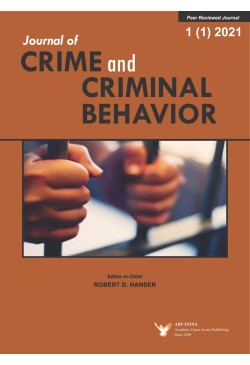
Journal of Crime and Criminal Behavior
Frequency :Bi-Annual
ISSN :2583-0244
Peer Reviewed Journal
Introduction to “Juvenile Delinquency and Justice”
The Impact of Trusted Adults and Friends on Fear and Avoidance Behaviors at School
Limited research has explored how having a trusted adult or friend in a school setting impacts students’ perceptions of school safety and their safety-related behaviors at school. We use data from 447 public high school students in a southeastern state to explore that relationship. Results indicate that those youths who had a trusted adult at school were less fearful than their counterparts while having a trusted friend did not affect either fear of crime or avoidance behaviors. Youths who had been victims of bullying were both significantly more fearful of victimization and were significantly more likely to engage in avoidance behaviors. Implications for school policy and research are discussed.
Keywords: Social support, school safety, fear of crime, avoidance behaviors
David C. May, Makeela J. Wells, Megan Stubbs-Richardson, Tawny N. Evans-Mccleon & H. Colleen Sinclair (2023). The Impact of Trusted Adults and Friends on Fear and Avoidance Behaviors at School. Journal of Crime and Criminal Behavior, 3: 2, pp. 277-298. https://doi.org/10.47509/JCCB.2023.v03i02.01
Street Trading and Juvenile Delinquency: Evidence from Major Motor Parks in Enugu State, Nigeria
This study examines street trading and juvenile delinquency drawing data from major motor parks in Enugu state, Nigeria. Street trading holds obvious implications to both adults and juveniles, but the situation of the juvenile remains critical in relation to unique factors such as socio-economic status, cultural, traditional, and economic circumstances, which impacts juveniles’ experiences. This study was framed on Cloward and Ohlin’s Differential Opportunity theory. Qualitative method was adopted, whereby thirty young persons aged 13-17 years were selected across six major motor parks in Enugu State using purposive sampling, and in-depth interview administered. Findings show that street trading was not the preferred choice for the young persons who engage in it; rather street trading is a function of poverty in which these juveniles find themselves.
Keywords: Hawking, Juvenile delinquency, Juvenile work, Motor Park, Street trading.
Obinna J. Eze (2023). Street Trading and Juvenile Delinquency: Evidence from Major Motor Parks in Enugu State, Nigeria. Journal of Crime and Criminal Behavior, 3: 2, pp. 299-312. https://doi.org/10.47509/JCCB.2023.v03i02.02
Perceived Barriers to Treatment Initiation amongst Justice-Involved Youth and Their Caregivers
Elizabeth Joseph, Jennifer E. Becan, Thomas Sease, Ashley Gainey, Brooke Preston, Kevin Knight & Danica Knight (2023). Perceived Barriers to Treatment Initiation amongst Justice-Involved Youth and their Caregivers. Journal of Crime and Criminal Behavior, 3: 2, pp. 313-328. https://doi.org/10.47509/JCCB.2023.v03i02.03
Do School Resource Officers Really Refer Black Students to the Justice System for Less Serious Offenses?
For the past two decades, scholars have argued that School Resource Officers (SROs) have increased the size of the school-to-prison pipeline by referring students to the justice system for minor offenses committed at school. Nevertheless, most of these studies (1) do not clearly distinguish between arrests initiated by the school, law enforcement responding to violations on school property, and those initiated by the SRO and (2) do not provide details on the type of offenses for which Black and White students are referred. In this paper, we use referral data from a southeastern state to begin responding to those questions. Our findings suggest that SROs look similar to schools in terms of the type of incidents for which students are referred to the justice system, Black students are disproportionately referred to the justice system for all types of offenses, and SRO referrals for minor offenses are similar for Black and White students. Implications for policy and future research are discussed.
David C. May, Raymond Barranco, Preston C. Roberts & Angela A. Robertson (2023). Do School Resource Officers Really Refer Black Students to the Justice System for Less Serious Offenses?. Journal of Crime and Criminal Behavior, 3: 2, pp. 329-352. https://doi.org/10.47509/JCCB.2023.v03i02.04
Understanding the Effects of Sexual Victimization on Substance Use Among American Indian Youth: Exploring the Moderating Effects of Cultural Identity
Korey Phelan (2023). Understanding the Effects of Sexual Victimization on Substance Use Among American Indian Youth: Exploring the Moderating Effects of Cultural Identity. Journal of Crime and Criminal Behavior, 3: 2, pp. 353-381. https://doi.org/10.47509/JCCB.2023.v03i02.05
Gambling and Drug Use: An Analysis of Risky Behaviours Among Adolescents
Craig J. Forsyth, Tina H. Deshotels, Jing Chen, Raymond W. Biggar, Jr. (2023). Gambling and Drug Use: An Analysis of Risky Behaviours among Adolescents. Journal of Crime and Criminal Behavior, 3: 2, pp. 383-394. https://doi.org/10.47509/JCCB.2023.v03i02.06
A Comparison of Juvenile Misconduct in Residential Facilities in Florida by Gender
Briana Ponce & Daniel Scott (2023). A Comparison of Juvenile Misconduct in Residential Facilities in Florida by Gender. Journal of Crime and Criminal Behavior, 3: 2, pp. 395-416. https://doi.org/10.47509/JCCB.2023.v03i02.07
The Influence of Neighbourhood Characteristics on the Public’s Confidence in the Police to Protect Them
Terrence T. Allen & Ahmed Whitt (2023). The Influence of Neighbourhood Characteristics on the Public’s Confidence in the Police to Protect them. Journal of Crime and Criminal Behavior, 3: 2, pp. 417-432. https://doi.org/10.47509/JCCB.2023.v03i02.08
Goals, Control, & Empowerment: A Comparison of Boy and Girl ever gang Involvement
Keywords: gang, gender, mental health, juvenile
Daniel Scott & Brittany Hood (2023). Goals, Control, & Empowerment: A Comparison of Boy and Girl ever gang Involvement. Journal of Crime and Criminal Behavior, 3: 2, pp. 433-456. https://doi.org/10.47509/JCCB.2023.v03i02.09